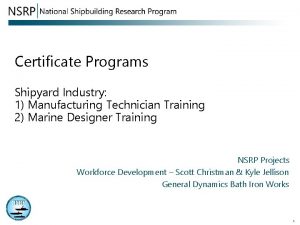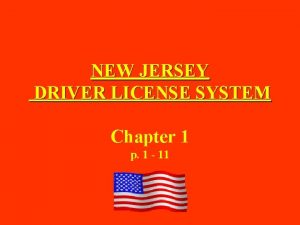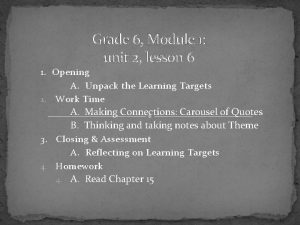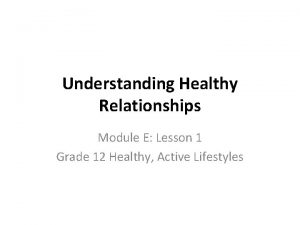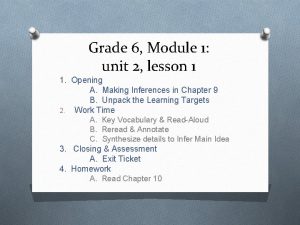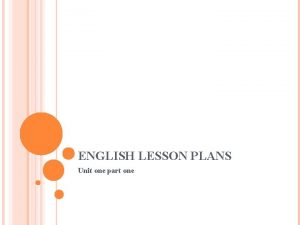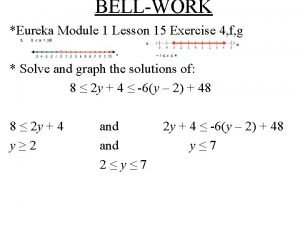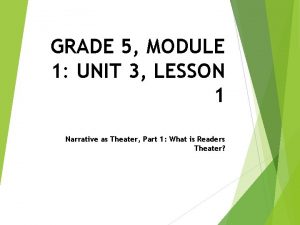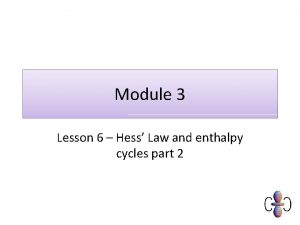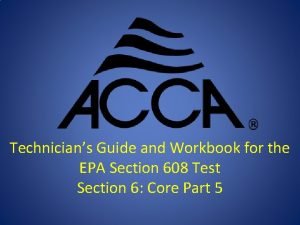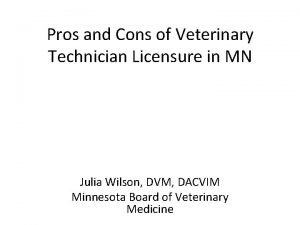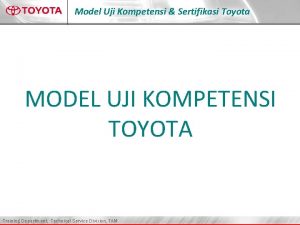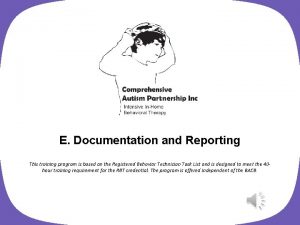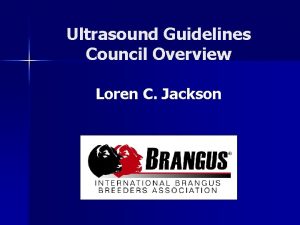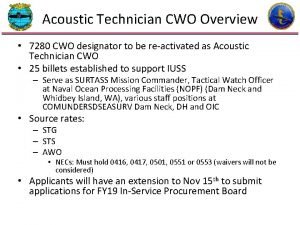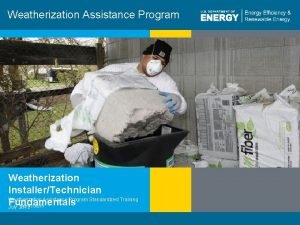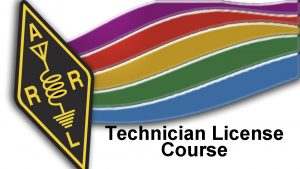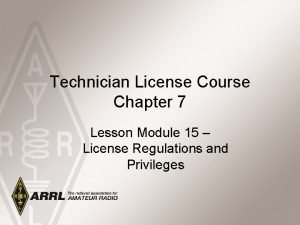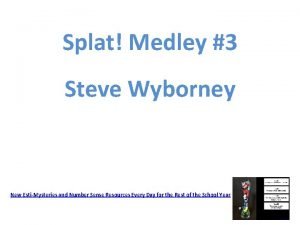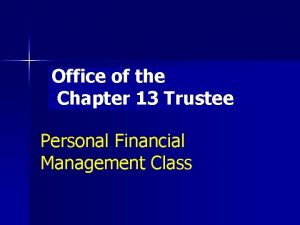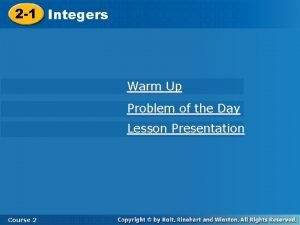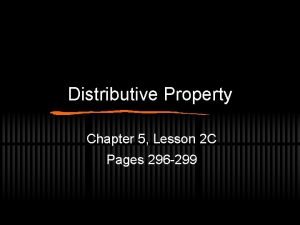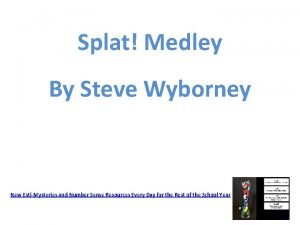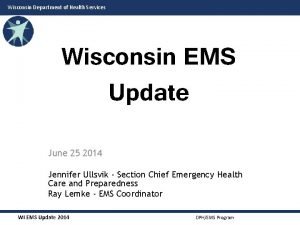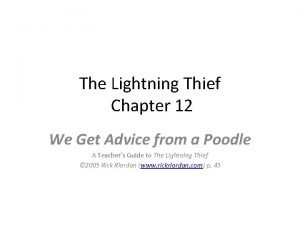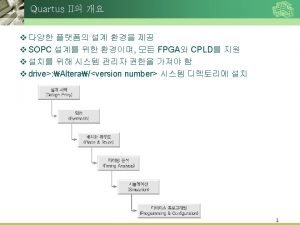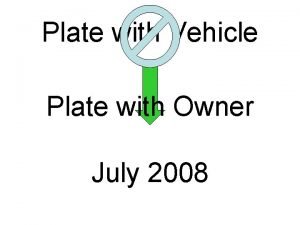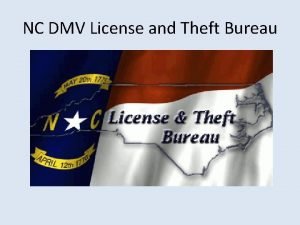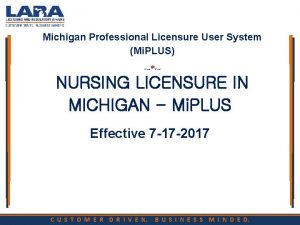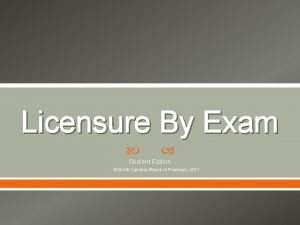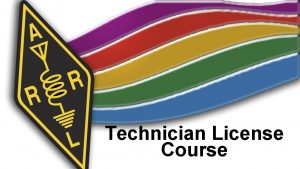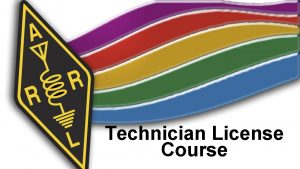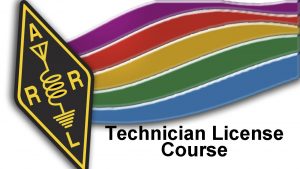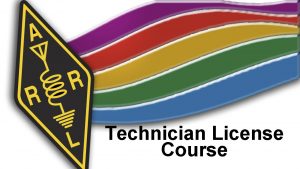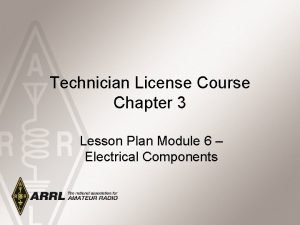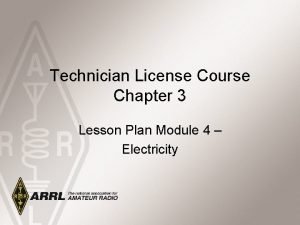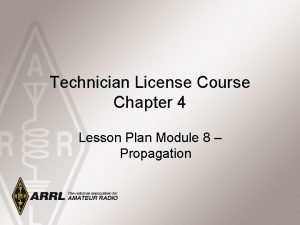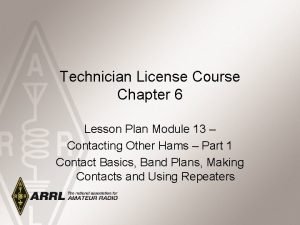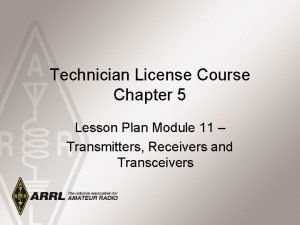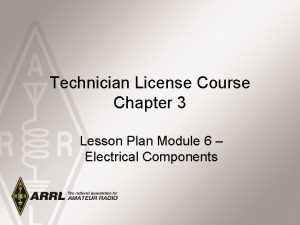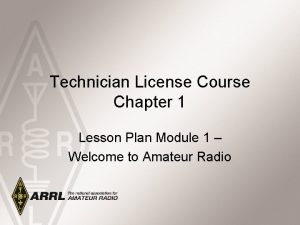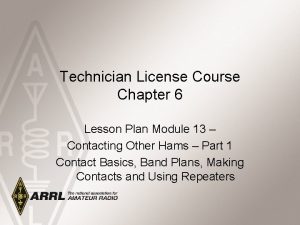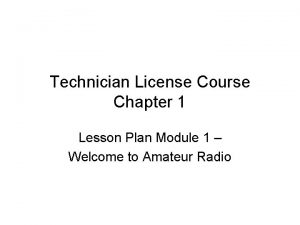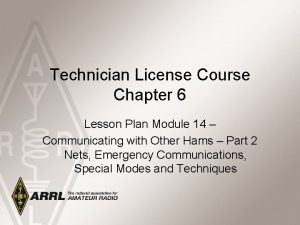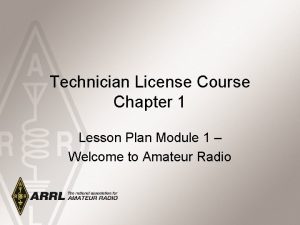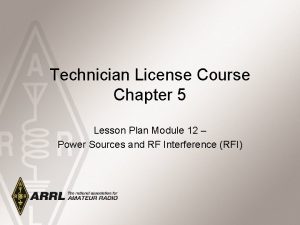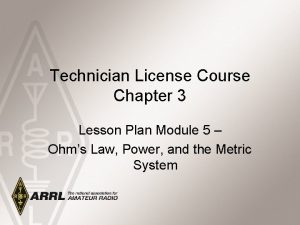Technician License Course Chapter 4 Lesson Plan Module


















































































- Slides: 82

Technician License Course Chapter 4 Lesson Plan Module 10 – Practical Antennas

The Dipole • Most basic antenna • Total length is ½ wavelength (½ l) • Usual construction: • Two equal halves of wire, rod, or tubing • Feed line connected in the middle • Length (in feet) usually estimated • 468 / frequency (in MHz) – often too short 2014 Technician License Course

The Dipole • Radiates strongest broadside to the dipole, weakest off the ends • If oriented horizontally, the radiated waves are horizontally polarized • 3 D radiation pattern looks like a donut or bagel • This is a free-space picture 2014 Technician License Course

The Ground-Plane 2014 Technician License Course

The Ground-Plane • One-half of a dipole (1/4 -wavelength long) oriented perpendicularly to a ground plane that acts as an “electrical mirror” • Replaces the dipole’s missing half • Any conducting surface can act as the ground-plane, including the ground! • Car roof or trunk, or other metal surface • Radial wires 2014 Technician License Course

The Rubber Duck • • Coiled wire coated in tough plastic Convenient size, rugged enough for handheld use The radio and operator make up the ground plane Small size equals compromise performance • Hold vertically to maximize range • Doesn’t work well inside vehicles due to metal body shielding signal • For mobile use, replace rubber duck with an external magnet-mount or permanent antenna 2014 Technician License Course

Dipole Construction • Start with excess length (490 / f) and adjust • To raise resonant frequency, shorten each half equally 2014 Technician License Course

Ground-Plane Construction • Length (in feet) usually estimated • 234 / frequency (in MHz) – often short, start long and trim to length • Thickness of whip or rod also affects calculated length • Vertical ground-plane antennas are omnidirectional • Mount mobile whips in center of roof or trunk for best coverage 2014 Technician License Course

Ground-Plane Construction • Lengthening a ¼-wavelength VHF/UHF groundplane to 5/8 wavelengths focuses more signal toward the horizon which usually improves range. • At HF, vertical antenna size is quite large. • 40 meter ¼-wavelength whip is about 32 feet • Inserting an inductor makes the antenna longer electrically • Reduces physical length required 2014 Technician License Course

Directional (Beam) Antennas • Beam antennas focus or direct RF energy in a desired direction. • Gain improves range • Reduces reception in unwanted directions • Reduces interference to and from other stations • Directional characteristics are the same for receiving as they are for transmitting. 2014 Technician License Course

Directional (Beam) Antennas Yagi Quads 2014 Technician License Course

Directional (Beam) Antennas • Used for “DXing” to obtain maximum range for contacts • Can be used at VHF/UHF to avoid multipath and bypass obstructions • Use vertical elements for repeaters and FM simplex contacts • Use horizontal elements for CW and SSB contacts to reduce ground losses 2014 Technician License Course

Directional (Beam) Antennas • At microwave frequencies (above 1 GHz) it becomes practical to use a dish antenna • Short wavelength • High gain • Small size 2014 Technician License Course

Practical Feed Lines • Coaxial cables • Larger diameter cables have lower loss • Loss is measured in d. B/foot • Loss increases with frequency • Keep water out! Protect the jacket from cuts and cracks and ultraviolet exposure. • Some cable is UV-rated 2014 Technician License Course

Common Coaxial Cables • • • RG-174: miniature, short connections only RG-58: 0. 2" OD, lossy at VHF/UHF RG-8 X: 0. 25" OD, good through low VHF RG-8/RG-213; 0. 4" OD, used through UHF Hard line: ½" to multiple inch OD, used through microwave • Most coax is 50 Ω or 75 Ω 2014 Technician License Course

Coaxial Connectors • UHF • SO-239/PL-259 • • BNC N SMA F (cable TV) 2014 Technician License Course

Installing Coaxial Connectors • Soldering is the traditional way • Use rosin-core solder and avoid “cold” solder joints • See The Art of Soldering on the ARRL website • Crimp connectors are becoming widely used by hams • Obtain and learn to use proper crimping tools 2014 Technician License Course

Waterproofing Connectors • MUST be waterproofed for use outdoors • Type N are waterproof but still usually protected anyway • Use good-quality electrical tape first, then a layer of self-vulcanizing tape, then another covering of electrical tape • Air-core coaxial cable requires special connectors and techniques to waterproof 2014 Technician License Course

Practical Feed Lines • Open-wire feed lines • • • Flexing will eventually break conductors Vulnerable to abrasion and twisting Rain, snow, and ice do affect the line Lower loss than coax, generally Higher impedance may complicate use 2014 Technician License Course

Feed Line Equipment • • Wattmeters SWR Meters Antenna Tuners Antenna Analyzers 2014 Technician License Course

Wattmeters • Most wattmeters are directional • Sensitive to direction of power flow • Read forward and reflected power • Use a sensing element • SWR is computed from power values • Table or formula 2014 Technician License Course

SWR Meters • Measure SWR directly by sensing power flow in the line • Usually installed at the transmitter 2014 Technician License Course

Antenna Tuners • Don’t really “tune the antenna” • Transform impedances at the end of the feed line to 50 Ω which reduces SWR to 1: 1 • Antenna feed point impedance unchanged • Feed line SWR unchanged • Also called impedance matchers, transmatches, matchboxes, other trade names 2014 Technician License Course

How to Use an Antenna Tuner • Transmit a low-power signal • Monitor the SWR meter • Adjust the tuner until minimum SWR is achieved 2014 Technician License Course

Antenna Analyzers • Low-power signal source, frequency counter, and SWR meter in one package • Makes antenna and cable measurements without transmitting a full-power signal • Available for HF through UHF and microwave • Very handy for adjusting and troubleshooting antennas and feed lines 2014 Technician License Course

Practice Questions 2014 Technician License Course

What antenna polarization is normally used for long-distance weak-signal CW and SSB contacts using the VHF and UHF bands? A. Right-hand circular B. Left-hand circular C. Horizontal D. Vertical T 3 A 03 HRLM (4 -15) 2014 Technician License Course

What antenna polarization is normally used for long-distance weak-signal CW and SSB contacts using the VHF and UHF bands? A. Right-hand circular B. Left-hand circular C. Horizontal D. Vertical T 3 A 03 HRLM (4 -15) 2014 Technician License Course

When using a directional antenna, how might your station be able to access a distant repeater if buildings or obstructions are blocking the direct line of sight path? A. Change from vertical to horizontal polarization B. Try to find a path that reflects signals to the repeater C. Try the long path D. Increase the antenna SWR T 3 A 05 HRLM (4 -14) 2014 Technician License Course

When using a directional antenna, how might your station be able to access a distant repeater if buildings or obstructions are blocking the direct line of sight path? A. Change from vertical to horizontal polarization B. Try to find a path that reflects signals to the repeater C. Try the long path D. Increase the antenna SWR T 3 A 05 HRLM (4 -14) 2014 Technician License Course

Where should an in-line SWR meter be connected to monitor the standing wave ratio of the station antenna system? A. In series with the feed line, between the transmitter and antenna B. In series with the stations ground C. In parallel with the push-to-talk line and the antenna D. In series with the power cable, as close as possible to the radio T 4 A 05 HRLM (4 -18) 2014 Technician License Course

Where should an in-line SWR meter be connected to monitor the standing wave ratio of the station antenna system? A. In series with the feed line, between the transmitter and antenna B. In series with the stations ground C. In parallel with the push-to-talk line and the antenna D. In series with the power cable, as close as possible to the radio T 4 A 05 HRLM (4 -18) 2014 Technician License Course

Which of the following instruments can be used to determine if an antenna is resonant at the desired operating frequency? A. A VTVM B. An antenna analyzer C. A Q meter D. A frequency counter T 7 C 02 HRLM (4 -19) 2014 Technician License Course

Which of the following instruments can be used to determine if an antenna is resonant at the desired operating frequency? A. A VTVM B. An antenna analyzer C. A Q meter D. A frequency counter T 7 C 02 HRLM (4 -19) 2014 Technician License Course

What instrument other than an SWR meter could you use to determine if a feed line and antenna are properly matched? A. Voltmeter B. Ohmmeter C. Iambic pentameter D. Directional wattmeter T 7 C 08 HRLM (4 -18) 2014 Technician License Course

What instrument other than an SWR meter could you use to determine if a feed line and antenna are properly matched? A. Voltmeter B. Ohmmeter C. Iambic pentameter D. Directional wattmeter T 7 C 08 HRLM (4 -18) 2014 Technician License Course

Which of the following is the most common cause for failure of coaxial cables? A. Moisture contamination B. Gamma rays C. The velocity factor exceeds 1. 0 D. Overloading T 7 C 09 HRLM (4 -16) 2014 Technician License Course

Which of the following is the most common cause for failure of coaxial cables? A. Moisture contamination B. Gamma rays C. The velocity factor exceeds 1. 0 D. Overloading T 7 C 09 HRLM (4 -16) 2014 Technician License Course

Why should the outer jacket of coaxial cable be resistant to ultraviolet light? A. Ultraviolet resistant jackets prevent harmonic radiation B. Ultraviolet light can increase losses in the cable’s jacket C. Ultraviolet and RF signals can mix together, causing interference D. Ultraviolet light can damage the jacket and allow water to enter the cable T 7 C 10 HRLM (4 -16) 2014 Technician License Course

Why should the outer jacket of coaxial cable be resistant to ultraviolet light? A. Ultraviolet resistant jackets prevent harmonic radiation B. Ultraviolet light can increase losses in the cable’s jacket C. Ultraviolet and RF signals can mix together, causing interference D. Ultraviolet light can damage the jacket and allow water to enter the cable T 7 C 10 HRLM (4 -16) 2014 Technician License Course

What is a disadvantage of air core coaxial cable when compared to foam or solid dielectric types? A. It has more loss per foot B. It cannot be used for VHF or UHF antennas C. It requires special techniques to prevent water absorption D. It cannot be used at below freezing temperatures T 7 C 11 HRLM (4 -17) 2014 Technician License Course

What is a disadvantage of air core coaxial cable when compared to foam or solid dielectric types? A. It has more loss per foot B. It cannot be used for VHF or UHF antennas C. It requires special techniques to prevent water absorption D. It cannot be used at below freezing temperatures T 7 C 11 HRLM (4 -17) 2014 Technician License Course

Which of the following is a common use of coaxial cable? A. Carrying dc power from a vehicle battery to a mobile radio B. Carrying RF signals between a radio and antenna C. C. Securing masts, tubing, and other cylindrical objects on towers D. D. Connecting data signals from a TNC to a computer T 7 C 12 HRLM (4 -9) 2014 Technician License Course

Which of the following is a common use of coaxial cable? A. Carrying dc power from a vehicle battery to a mobile radio B. Carrying RF signals between a radio and antenna C. C. Securing masts, tubing, and other cylindrical objects on towers D. D. Connecting data signals from a TNC to a computer T 7 C 12 HRLM (4 -9) 2014 Technician License Course

Which of the following types of solder is best for radio and electronic use? A. Acid-core solder B. Silver solder C. Rosin-core solder D. Aluminum solder T 7 D 08 HRLM (4 -17) 2014 Technician License Course

Which of the following types of solder is best for radio and electronic use? A. Acid-core solder B. Silver solder C. Rosin-core solder D. Aluminum solder T 7 D 08 HRLM (4 -17) 2014 Technician License Course

What is the characteristic appearance of a cold solder joint? A. Dark black spots B. A bright or shiny surface C. A grainy or dull surface D. A greenish tint T 7 D 09 HRLM (4 -17) 2014 Technician License Course

What is the characteristic appearance of a cold solder joint? A. Dark black spots B. A bright or shiny surface C. A grainy or dull surface D. A greenish tint T 7 D 09 HRLM (4 -17) 2014 Technician License Course

What is a beam antenna? A. An antenna built from aluminum I-beams B. An omnidirectional antenna invented by Clarence Beam C. An antenna that concentrates signals in one direction D. An antenna that reverses the phase of received signals T 9 A 01 HRLM (4 -14) 2014 Technician License Course

What is a beam antenna? A. An antenna built from aluminum I-beams B. An omnidirectional antenna invented by Clarence Beam C. An antenna that concentrates signals in one direction D. An antenna that reverses the phase of received signals T 9 A 01 HRLM (4 -14) 2014 Technician License Course

Which of the following describes a simple dipole mounted so the conductor is parallel to the Earth’s surface? A. A ground wave antenna B. A horizontally polarized antenna C. A rhombic antenna D. A vertically polarized antenna T 9 A 03 HRLM (4 -11) 2014 Technician License Course

Which of the following describes a simple dipole mounted so the conductor is parallel to the Earth’s surface? A. A ground wave antenna B. A horizontally polarized antenna C. A rhombic antenna D. A vertically polarized antenna T 9 A 03 HRLM (4 -11) 2014 Technician License Course

What is a disadvantage of the “rubber duck” antenna supplied with most handheld radio transceivers? A. It does not transmit or receive as effectively as a fullsized antenna B. It transmits a circularly polarized signal C. If the rubber end cap is lost it will unravel very quickly D. All of these choices are correct T 9 A 04 HRLM (4 -13) 2014 Technician License Course

What is a disadvantage of the “rubber duck” antenna supplied with most handheld radio transceivers? A. It does not transmit or receive as effectively as a fullsized antenna B. It transmits a circularly polarized signal C. If the rubber end cap is lost it will unravel very quickly D. All of these choices are correct T 9 A 04 HRLM (4 -13) 2014 Technician License Course

How would you change a dipole antenna to make it resonant on a higher frequency? A. Lengthen it B. Insert coils in series with radiating wires C. Shorten it D. Add capacitive loading to the ends of the radiating wires T 9 A 05 HRLM (4 -12) 2014 Technician License Course

How would you change a dipole antenna to make it resonant on a higher frequency? A. Lengthen it B. Insert coils in series with radiating wires C. Shorten it D. Add capacitive loading to the ends of the radiating wires T 9 A 05 HRLM (4 -12) 2014 Technician License Course

What type of antennas are the quad, Yagi, and dish? A. Non-resonant antennas B. Loop antennas C. Directional antennas D. Isotropic antennas T 9 A 06 HRLM (4 -15) 2014 Technician License Course

What type of antennas are the quad, Yagi, and dish? A. Non-resonant antennas B. Loop antennas C. Directional antennas D. Isotropic antennas T 9 A 06 HRLM (4 -15) 2014 Technician License Course

What is a good reason not to use a “rubber duck” antenna inside your car? A. Signals can be significantly weaker than when it is outside of the vehicle B. It might cause your radio to overheat C. The SWR might decrease, decreasing the signal strength D. All of these choices are correct T 9 A 07 HRLM (4 -13) 2014 Technician License Course

What is a good reason not to use a “rubber duck” antenna inside your car? A. Signals can be significantly weaker than when it is outside of the vehicle B. It might cause your radio to overheat C. The SWR might decrease, decreasing the signal strength D. All of these choices are correct T 9 A 07 HRLM (4 -13) 2014 Technician License Course

What is the approximate length, in inches, of a quarter-wavelength vertical antenna for 146 MHz? A. 112 B. 50 C. 19 D. 12 T 9 A 08 HRLM (4 -11) 2014 Technician License Course

What is the approximate length, in inches, of a quarter-wavelength vertical antenna for 146 MHz? A. 112 B. 50 C. 19 D. 12 T 9 A 08 HRLM (4 -11) 2014 Technician License Course

What is the approximate length, in inches, of a 6 meter 1/2 -wavelength wire dipole antenna? A. 6 B. 50 C. 112 D. 236 T 9 A 09 HRLM (4 -11) 2014 Technician License Course

What is the approximate length, in inches, of a 6 meter 1/2 -wavelength wire dipole antenna? A. 6 B. 50 C. 112 D. 236 T 9 A 09 HRLM (4 -11) 2014 Technician License Course

In which direction is the radiation strongest from a half-wave dipole antenna in free space? A. Equally in all directions B. Off the ends of the antenna C. Broadside to the antenna D. In the direction of the feed line T 9 A 10 HRLM (4 -11) 2014 Technician License Course

In which direction is the radiation strongest from a half-wave dipole antenna in free space? A. Equally in all directions B. Off the ends of the antenna C. Broadside to the antenna D. In the direction of the feed line T 9 A 10 HRLM (4 -11) 2014 Technician License Course

What is a reason to use a properly mounted 5/8 wavelength antenna for VHF or UHF mobile service? A. It offers a lower angle of radiation than a 1/4 wavelength antenna and usually provides improved coverage B. It features a very high angle of radiation and is better for communicating via a repeater C. The 5/8 wavelength antenna completely eliminates distortion caused by reflected signals D. The 5/8 wavelength antenna offers a 10 -times power gain over a 1/4 wavelength design T 9 A 12 HRLM (4 -13) 2014 Technician License Course

What is a reason to use a properly mounted 5/8 wavelength antenna for VHF or UHF mobile service? A. It offers a lower angle of radiation than a 1/4 wavelength antenna and usually provides improved coverage B. It features a very high angle of radiation and is better for communicating via a repeater C. The 5/8 wavelength antenna completely eliminates distortion caused by reflected signals D. The 5/8 wavelength antenna offers a 10 -times power gain over a 1/4 wavelength design T 9 A 12 HRLM (4 -13) 2014 Technician License Course

Why are VHF or UHF mobile antennas often mounted in the center of the vehicle roof? A. Roof mounts have the lowest possible SWR of any mounting configuration B. Only roof mounting can guarantee a vertically polarized signal C. A roof mounted antenna normally provides the most uniform radiation pattern D. Roof mounted antennas are always the easiest to install T 9 A 13 HRLM (4 -13) 2014 Technician License Course

Why are VHF or UHF mobile antennas often mounted in the center of the vehicle roof? A. Roof mounts have the lowest possible SWR of any mounting configuration B. Only roof mounting can guarantee a vertically polarized signal C. A roof mounted antenna normally provides the most uniform radiation pattern D. Roof mounted antennas are always the easiest to install T 9 A 13 HRLM (4 -13) 2014 Technician License Course

Which of the following terms describes a type of “loading” when referring to an antenna? A. Inserting an inductor in the radiating portion of the antenna to make it electrically longer B. Inserting a resistor in the radiating portion of the antenna to make it resonant C. Installing a spring at the base of the antenna to absorb the effects of collisions with other objects D. Making the antenna heavier so it will resist wind effects when in motion T 9 A 14 HRLM (4 -13) 2014 Technician License Course

Which of the following terms describes a type of “loading” when referring to an antenna? A. Inserting an inductor in the radiating portion of the antenna to make it electrically longer B. Inserting a resistor in the radiating portion of the antenna to make it resonant C. Installing a spring at the base of the antenna to absorb the effects of collisions with other objects D. Making the antenna heavier so it will resist wind effects when in motion T 9 A 14 HRLM (4 -13) 2014 Technician License Course

What does an antenna tuner do? A. It matches the antenna system impedance to the transceiver's output impedance B. It helps a receiver automatically tune in weak stations C. It allows an antenna to be used on both transmit and receive D. It automatically selects the proper antenna for the frequency band being used T 9 B 04 HRLM (4 -18) 2014 Technician License Course

What does an antenna tuner do? A. It matches the antenna system impedance to the transceiver's output impedance B. It helps a receiver automatically tune in weak stations C. It allows an antenna to be used on both transmit and receive D. It automatically selects the proper antenna for the frequency band being used T 9 B 04 HRLM (4 -18) 2014 Technician License Course

Which of the following connectors is most suitable for frequencies above 400 MHz? A. A UHF (PL-259/SO-239) connector B. A Type N connector C. An RS-213 connector D. A DB-25 connector T 9 B 06 HRLM (4 -17) 2014 Technician License Course

Which of the following connectors is most suitable for frequencies above 400 MHz? A. A UHF (PL-259/SO-239) connector B. A Type N connector C. An RS-213 connector D. A DB-25 connector T 9 B 06 HRLM (4 -17) 2014 Technician License Course

Which of the following is true of PL-259 type coax connectors? A. They are preferred for microwave operation B. They are water tight C. The are commonly used at HF frequencies D. They are a bayonet type connector T 9 B 07 HRLM (4 -17) 2014 Technician License Course

Which of the following is true of PL-259 type coax connectors? A. They are preferred for microwave operation B. They are water tight C. The are commonly used at HF frequencies D. They are a bayonet type connector T 9 B 07 HRLM (4 -17) 2014 Technician License Course

Why should coax connectors exposed to the weather be sealed against water intrusion? A. To prevent an increase in feed line loss B. To prevent interference to telephones C. To keep the jacket from becoming loose D. All of these choices are correct T 9 B 08 HRLM (4 -17) 2014 Technician License Course

Why should coax connectors exposed to the weather be sealed against water intrusion? A. To prevent an increase in feed line loss B. To prevent interference to telephones C. To keep the jacket from becoming loose D. All of these choices are correct T 9 B 08 HRLM (4 -17) 2014 Technician License Course

What electrical difference exists between the smaller RG-58 and larger RG-8 coaxial cables? A. There is no significant difference between the two types B. RG-58 cable has less loss at a given frequency C. RG-8 cable has less loss at a given frequency D. RG-58 cable can handle higher power levels T 9 B 10 HRLM (4 -16) 2014 Technician License Course

What electrical difference exists between the smaller RG-58 and larger RG-8 coaxial cables? A. There is no significant difference between the two types B. RG-58 cable has less loss at a given frequency C. RG-8 cable has less loss at a given frequency D. RG-58 cable can handle higher power levels T 9 B 10 HRLM (4 -16) 2014 Technician License Course
 Manufacturing technician license
Manufacturing technician license Manufacturing tech license
Manufacturing tech license Micro lesson planning
Micro lesson planning C device module module 1
C device module module 1 Hse culture ladder
Hse culture ladder Course module sample
Course module sample Where did ravi hide the kitten
Where did ravi hide the kitten T junction flemish bond
T junction flemish bond Course title and course number
Course title and course number Chaine parallèle muscle
Chaine parallèle muscle Altering a driver's license may result in
Altering a driver's license may result in Chapter 1 nj driver license system
Chapter 1 nj driver license system Chapter 1 the new jersey driver license system answers
Chapter 1 the new jersey driver license system answers What is an overall state of well-being or total health
What is an overall state of well-being or total health Lesson 3 a new plan of government
Lesson 3 a new plan of government The great depression lesson 2 hardship and suffering
The great depression lesson 2 hardship and suffering Module 5 lesson 5
Module 5 lesson 5 Unit 2 lesson 6
Unit 2 lesson 6 Practical/logistical issues in relationships examples
Practical/logistical issues in relationships examples Eureka math grade 6 module 1 lesson 1
Eureka math grade 6 module 1 lesson 1 Module eleven lesson one self check quiz
Module eleven lesson one self check quiz Eureka math algebra 1 module 1 lesson 15
Eureka math algebra 1 module 1 lesson 15 Grade 5 module 1 lesson 1
Grade 5 module 1 lesson 1 Module 15 lesson 1 central angles and inscribed angles
Module 15 lesson 1 central angles and inscribed angles Module 3 lesson 6
Module 3 lesson 6 What is coring in pharmacy
What is coring in pharmacy How long must a technician evacuating refrigerant
How long must a technician evacuating refrigerant Vet tech pros and cons
Vet tech pros and cons Maximo pm forecasting
Maximo pm forecasting Certified calibration technician
Certified calibration technician Support services career pathway
Support services career pathway Radar and sonar technician career cluster
Radar and sonar technician career cluster Technician a says that the bulb trade number
Technician a says that the bulb trade number Toyota technician certification
Toyota technician certification Micromain mobile
Micromain mobile Mtm pharmacy technician
Mtm pharmacy technician Maximo scheduling software
Maximo scheduling software Rbt session note example
Rbt session note example Surface repair technician
Surface repair technician She technician apprenticeship
She technician apprenticeship Translator
Translator Live technician
Live technician Carcass ultrasound technician training
Carcass ultrasound technician training Coding and logic exam questions
Coding and logic exam questions A csi lab technician _____.
A csi lab technician _____. Horticultural technician apprentice
Horticultural technician apprentice Acoustic technician
Acoustic technician Shane palmer concreting
Shane palmer concreting How to become a weatherization technician
How to become a weatherization technician Level 9 technician
Level 9 technician Technician class privileges
Technician class privileges Tracemp
Tracemp Pci wind turbine technician
Pci wind turbine technician Pharmacy technician george brown
Pharmacy technician george brown Cot skills simulator
Cot skills simulator Commonly damaged areas of a vehicle during hoisting
Commonly damaged areas of a vehicle during hoisting Ecc x ray technician
Ecc x ray technician Dtabc
Dtabc Course plan ppt
Course plan ppt Course 2 chapter 1 ratios and proportional reasoning
Course 2 chapter 1 ratios and proportional reasoning Steve wyborney splat
Steve wyborney splat Chapter 13 personal financial management course
Chapter 13 personal financial management course Integers warm up
Integers warm up 9(3+c+4) distributive property
9(3+c+4) distributive property Steve wyborney
Steve wyborney Work based learning license mn
Work based learning license mn Wi ems elicensing
Wi ems elicensing License smart register idtoken invalid input
License smart register idtoken invalid input Lightning thief chapter 12
Lightning thief chapter 12 Coin operated amusement machines georgia
Coin operated amusement machines georgia Tbote license
Tbote license Spla licensing reporting
Spla licensing reporting Quartus web edition download
Quartus web edition download Govcg
Govcg South dakota temporary license plates
South dakota temporary license plates Oregon nurse practice act
Oregon nurse practice act Omma transport license list
Omma transport license list Basic driver's license nj
Basic driver's license nj Graduated drivers license nj
Graduated drivers license nj Negotiating with sap
Negotiating with sap Dmv license renewal nc
Dmv license renewal nc Miplus nursing license renewal
Miplus nursing license renewal Ncbop
Ncbop
